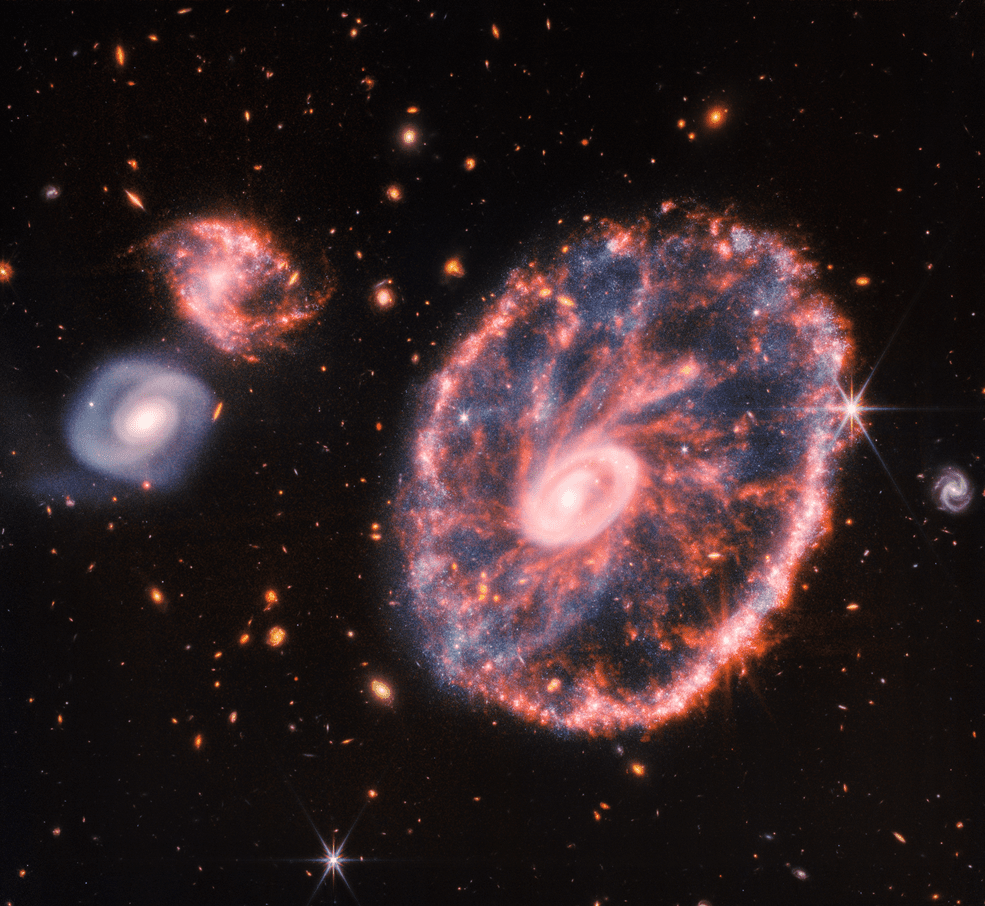The James Webb Space Telescope of NASA was able to peek into the disorder of the Cartwheel Galaxy, which led to the discovery of new information on the galaxy’s center black hole as well as the birth of stars. The intense infrared vision of Webb was able to generate this detailed picture of the Cartwheel galaxy and its two smaller partner galaxies against a background consisting of a great number of other galaxies. This picture presents a fresh perspective on the evolution of the Cartwheel Galaxy over the course of billions of years.
The Cartwheel Galaxy is a remarkable sight since it can be found in the Sculptor constellation, which is about 500 million light-years distant. An extreme event, a high-speed collision between a massive spiral galaxy and a smaller galaxy that is not visible in this picture, caused its appearance, which is similar to that of the wheel of a wagon. This is the cause of its appearance, which is similar to that of the wheel of a wagon. The Cartwheel is not an exception to the rule that galactic collisions result in a chain reaction of a variety of minor events occurring between the galaxies that were involved.
The collision had the most significant impact on the structure and form of the galaxy. The Cartwheel Galaxy has two rings: the inner ring is brilliant, and the ring that surrounds it is full of vibrant colors. These two rings spread outward from the center of the impact, much like ripples in a pond that are caused when a stone is thrown into the water. Because of these unique characteristics, astronomers refer to this structure as a “ring galaxy,” which is a structure that is less frequent than spiral galaxies such as the Milky Way.
The bright core has a large quantity of hot material contained inside it, and the brightest parts are the locations of enormous star clusters that are quite new. On the other hand, star formation and supernovas are the primary drivers of the expansion of the outer ring, which has occurred over the course of around 440 million years. This expanding ring is responsible for the birth of stars because it collides with the gas in its surroundings as it becomes larger.
Previous observations of the Cartwheel were made using a variety of telescopes, one of which being the Hubble Space Telescope. However, the view of the spectacular galaxy has been obscured by a significant quantity of dust, which may suggest that the mystery surrounding the galaxy is literal. As a result of Webb’s capacity to detect infrared light, previously unknown aspects of the Cartwheel’s makeup have been brought to light.

The Near-Infrared Camera, often known as NIRCam, is the main image on the James Webb Space Telescope. It observes light with wavelengths of 0.6 to 5 microns, a range known as the near-infrared, which may show even more stars than can be seen in visible light. This is due to the fact that when seen in infrared light, the dust has less of an effect on the visibility of young stars, many of which are still in the process of forming in the outer ring. The NIRCam data in this picture are represented by the colors blue, orange, and yellow respectively. Numerous individual blue dots may be seen around the galaxy. These blue dots represent individual stars or pockets of star formation. The clumpy morphologies associated with the young star groups seen out of the core are shown by NIRCam to be significantly different from the smooth distribution or form of the older star populations and thick dust found in the center of the galaxy.
However, in order to get a more nuanced understanding of the dust that is found across the galaxy, Webb’s Mid-Infrared Instrument is required (MIRI). In this composite picture, data from MIRI are shown in a red tint. It exposes places inside the Cartwheel Galaxy that are rich in hydrocarbons and other chemical compounds as well as silicate dust, similar to a significant portion of the dust that exists on Earth. These areas come together to create a series of spiraling spokes that, in essence, make up the skeleton of the galaxy. These spokes were also seen in earlier Hubble photos that were published in 2018, but they stand out quite clearly in this picture from the Webb telescope.
The insights made by Webb highlight the fact that the Cartwheel is now at a highly transitional stage. The galaxy, which before to the collision was probably a regular spiral galaxy similar to the Milky Way, will continue to alter as a result of the collision. Webb not only offers us a picture of the present condition of the Cartwheel, but it also sheds light on what has occurred to this galaxy prior and how it will develop in the future.












Leave a Reply